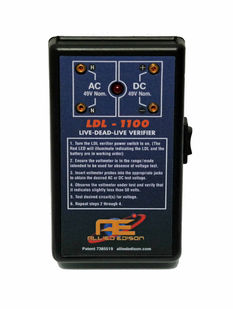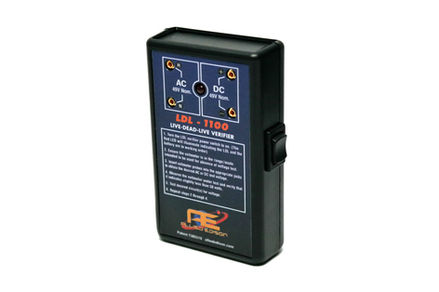

LDL-1100 Live Dead Live Verifier
LDL-1100 Live-Dead-Live Verifier
The Live Dead Live (LDL) Meter Verifier is a small, lightweight, robust, portable, handheld power supply. It supplies just under 50 volts, AC (rms) or DC with a maximum current of less than 5 mA at rated voltage. The LDL 1100 Meter Verifier is specifically designed to facilitate voltage verification tests on most digital multi-meters, electronic voltage detectors, voltage testers, neon test lights, tic tracers and other commonly used electrical voltage test apparatus, while keeping the user as electrically safe as possible with its extremely low “volt-amp” output.
$199.95
Click above to see expanded images

Allied Edison LDL-1100, LDL-1200 Live-Dead-Live Verifier Meters
Please click on the video above for complete information on the
LDL-1100 Live-Dead-Live Verifier Meter
Specifications:
INPUT: 9 volt battery.
OUTPUT VOLTAGE: 49 volts (rms).
OUTPUT CURRENT: Under 5 mA.
7.5 lb. pull force magnet
Switch auto shutoff and under voltage shutdown
Statistics:
Electrical hazards cause more than 300 deaths and 4,000 injuries in the workplace each year.
Electrical accidents rank sixth among all causes of work-related deaths in the United States.
During the work day, a worker is hurt every 30 minutes so severely from electricity that it requires time off the job.
Reference: Electrical Safety Foundation International (ESFI) – Electrical Safety in the Workplace Fact Sheet
Related Regulations:
OSHA 1910.333(a)(1)
OSHA has not accepted the argument that a qualified employee can work on energized circuits as safely as they can work on de-energized circuits. Therefore, OSHA is not leaving it to the employer’s discretion as to whether or not to de-energize electric circuits on the basis of convenience, custom, or expediency.
OSHA requires that all live parts to which an employee may be exposed shall be de-energized before the employee works on or near them, unless the employer can demonstrate that de-energizing introduces additional or increased hazards or is infeasible due to equipment design or operational limitations.
NFPA – National Fire Protection Association (Article 120)
120.1 Process of Achieving an Electrically Safe Work Condition. An electrically safe work condition shall be achieved when performed in accordance with the procedures of 120.2 and verified by the following process:
-
Determine all possible sources of electrical supply to the specific equipment. Check applicable up-to-date drawings, diagrams, and identification tags.
-
After properly interrupting the load current, open the disconnecting device(s) for each source.
-
Wherever possible, visually verify that all blades of the disconnecting devices are fully open or that drawout-type circuit breakers are withdrawn to the fully disconnected position.
-
Apply lockout/tagout devices in accordance with a documented and established policy.
-
Use an adequately rated voltage detector to test each phase conductor or circuit part to verify they are de-energized. Test each phase conductor or circuit part both phase-to-phase and phase-to-ground. Before and after each test, determine that the voltage detector is operating satisfactorily.
NIOSH – National Institute of Occupational Safety & Health
Before any work is done on a circuit, shut off the circuit, lock out and tag out the circuit at the distribution panel, then test the circuit to make sure it is de-energized.
Before ANY equipment inspections or repairs – even so-called low-voltage circuits – the current must be turned off at the switch box, and the switch must be padlocked in the OFF position. At the same time, the equipment must be securely tagged to warn everyone that work is being performed. Again, test circuits and equipment to ensure they are de-energized.
INPO – Institute of Nuclear Power Operations
Expectations have been established for voltage-detection work practices, such as “test-before-touch” and “live-dead-live” verifications. Workers are expected to understand the limitations of voltage-detectors, such as proximity testers. Thorough voltage-detection is expected. Voltage checks should include exposed electrical conductors or circuit parts in proximity to the circuit to be worked.
Practical Examples:
Example #1
A worker has to climb a high ladder or is on scaffolding 4 stories high in order to work on a circuit. What does the worker do to ensure the circuit is de-energized? In order to perform a “live-dead-live” test and check his meter, he would have to climb all the way down and try to find a live voltage source both before AND after testing the circuit he wants to work on.
Make it easy to be safe by using a portable Live-Dead-Live verifier.
Example #2
When working on a DC system, a worker cannot find a DC voltage source with which to check his meter to properly perform the “live-dead-live” test. What does the worker do to ensure the circuit is de-energized? I’d like to say the worker searches until he finds an appropriate DC source with which to test his meter, in reality, many times this vital test is not conducted. This is a perfect example of how needless accidents occur because of failing to perform a proper test.
Make it easy to be safe by using a portable Live-Dead-Live verifier.
Example #3
A worker with an LDL verifer needs to verify that he has properly de-energized the circuit he is working on. What does the worker do to ensure the circuit is de-energized?
-
He turns on his LDL verifier.
-
He tests his meter with the LDL verifier to ensure that is working properly.
-
He tests the circuit he is about to work on to see that it is dead.
-
He then retests his meter with the LDL verifier to show that it is working.
This entire operation took about one minute and now that worker can safely work on the de-energized circuit.
Make it easy to be safe by using a portable Live-Dead-Live verifier.
Portable Ground Detection Equipment, Electrical Safety Devices, and Power Supplies










